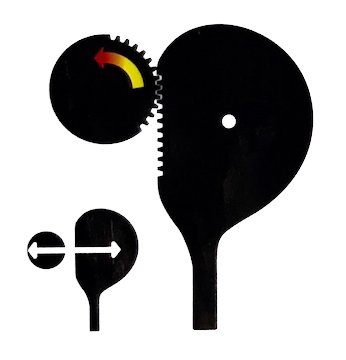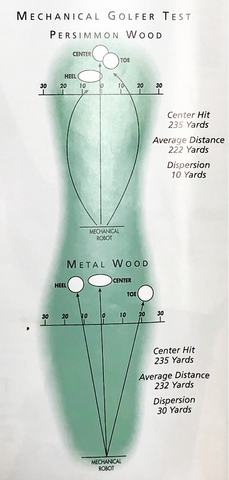‘Gear Effect’ And The Case For Persimmon Drivers
If you are an avid golfer, brace yourself for some sobering news: Data from the U.S. Golf Association using its robotic "Iron Byron" swing simulator have shown conclusively that, given identical shafts, a golf ball struck with a titanium head at 109 mph goes no farther than one struck with a persimmon head at 109 mph. In fact: Mike Austin was credited by Guinness World Records with hitting the longest drive in tournament play (471m/515 yards) in 1974 at Winterwood Golf Course using a steel shafted persimmon driver…
The Truth Behind Metal Clubs
Before metallic clubs flooded the market, persimmon was the material of choice for manufacturers of quality woods, and with good reason. A golfer can control the flight of the ball more consistently with persimmon than with metal and it gives you that glorious "thwack" sound off the tee (versus titanium's anemic "clink"). Nonetheless metal woods dominate market share today. Major manufacturers spend huge amounts of money getting their equipment into the hands of the top tour pros. Metal woods are much cheaper to produce than handcrafted Persimmon clubs leaving a large margin for promotion, advertising and sponsorship.
To take maximum advantage of a high COR metal driver (conforming to USGA standards) you’d have to have a very high swing speed and hit the club in the exact center of the face. There are not many golfers who can generate this speed with the necessary control. Thus, we believe there are many positive reasons for more golfers to play persimmon - they should hit the ball almost as far but with greater accuracy by utilizing the natural ‘Gear Effect’ of persimmon drivers.
Persimmon Clubs And The ‘Gear Effect’
 What is the ‘Gear Effect’ you ask? It’s the sidespin which is the result of an off-center hit with a club whose center of gravity is well back from the club face. As a general rule the gear effects shots as follows:Toe shot – club face twists right, imparts more hook spin/less slice spin to the ball. Heel shot – club face twists left, imparting more slice spin/less hook spin to the ball.
What is the ‘Gear Effect’ you ask? It’s the sidespin which is the result of an off-center hit with a club whose center of gravity is well back from the club face. As a general rule the gear effects shots as follows:Toe shot – club face twists right, imparts more hook spin/less slice spin to the ball. Heel shot – club face twists left, imparting more slice spin/less hook spin to the ball.
When you consider factors apart from simply The Gear Effect at the club face you can actually either amplify or diminish mistakes when hitting a ball off center depend on what club you are using.
Gear Effect Spin
 Gear Effect Spin is the rotation created from an off-center hit and the effect this has on the curvature of ball flight. Gear effect spin with persimmon clubs can actually act to self-correct a hit. For a ball hit on the toe, with a clubface square to the path, the tendency is for the clubhead to rotate open, pushing the ball to the right (RH golfer). However, as the clubface opens, the gear effect induces draw spin, tending to curve the ball back to the left. The clubhead rotation is what induces gear effect spin. If you look at persimmon heads, they tend to have pronounced face curvature (bulge and roll) This curvature causes a shot hit on the toe, for instance, to start a little further right in order to counteract the draw spin from the gear effect. Higher MOI in the newer clubeads means, with an equivalent shaft, the club itself will rotate less due to an off-center strike than a club with a lower MOI. Consequently, less gear effect spin.The internal friction of a Persimmon wood is 1000 times that of metal. Additionally, a persimmon’s deeper center of gravity makes it easy for players to work the ball utilizing the gear affect. See the screws on the club face, right in the sweet-spot? That's where the phrase, "hitting it on the screws" came from. Tour players loved it because of the feel and feedback they got from each strike. They could shape shots, which not many can do with today's drivers featuring heads that are up to 460cc in size. The persimmon driver could have just as easily been known as the "precision driver."
Gear Effect Spin is the rotation created from an off-center hit and the effect this has on the curvature of ball flight. Gear effect spin with persimmon clubs can actually act to self-correct a hit. For a ball hit on the toe, with a clubface square to the path, the tendency is for the clubhead to rotate open, pushing the ball to the right (RH golfer). However, as the clubface opens, the gear effect induces draw spin, tending to curve the ball back to the left. The clubhead rotation is what induces gear effect spin. If you look at persimmon heads, they tend to have pronounced face curvature (bulge and roll) This curvature causes a shot hit on the toe, for instance, to start a little further right in order to counteract the draw spin from the gear effect. Higher MOI in the newer clubeads means, with an equivalent shaft, the club itself will rotate less due to an off-center strike than a club with a lower MOI. Consequently, less gear effect spin.The internal friction of a Persimmon wood is 1000 times that of metal. Additionally, a persimmon’s deeper center of gravity makes it easy for players to work the ball utilizing the gear affect. See the screws on the club face, right in the sweet-spot? That's where the phrase, "hitting it on the screws" came from. Tour players loved it because of the feel and feedback they got from each strike. They could shape shots, which not many can do with today's drivers featuring heads that are up to 460cc in size. The persimmon driver could have just as easily been known as the "precision driver."
Conclusion
Golf is a gear centric sport, but it will always be a sport of skill. Gear affects performance and an argument can be made for almost anything having a positive or negative effect on the game with varying degrees of credibility. Persimmon isn’t as popular as it once was. The last PGA championship won with a persimmon driver was nearly 30 years ago. But tides are changing, golfers are returning to the roots of the game and they are beginning to appreciate the nuances of older equipment. We believe metal woods may help the average golfer by offering a greater distance on your average shot, but Persimmon can help make a golfer better than average. Driving persimmon clubs is for those who enjoy the experience of having control and want a better understanding of the game. We believe playing with the equipment historic courses were built around creates a better understanding for how the game was meant to be played. Ultimately it’s up to the individual golfer to make decisions on what works for them.


Real Legally Progesterone Visa Accepted Medicine Overseas Cheapeast Enlandaloyaw [url=https://bansocialism.com/]tadalafil cialis[/url] Broammarhymn Canadian Online Drug Site Reviews
Sorry, what does MOI stand for?
What does IMO stand for?
I started playing golf years ago, just as the metal woods were coming in. I played with a persimmon 5 wood in my bag for a while and I noticed the gear effect, and loved the club for it. It was almost like an automatic correction on direction. Anyway, times move on, but The new Speed Face technology seems to be Gear Effect cambering dressed up as something new so that club manufacturers can charge a lot of money for an old design.
] Amoxicillin Online hex.rhfx.louisvillegolf.shop.nls.wy https://mewkid.net/when-is-xuxlya2/
Leave a comment